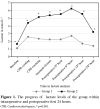Correlation between serum lactate levels and outcome in pediatric patients undergoing congenital heart surgery
- PMID: 32082767
- PMCID: PMC7018278
- DOI: 10.5606/tgkdc.dergisi.2018.15791
Correlation between serum lactate levels and outcome in pediatric patients undergoing congenital heart surgery
Abstract
Background: This study aimed to investigate the correlation between perioperative arterial lactate levels and morbidity and mortality in children undergoing cardiac surgery.
Methods: A total of 236 patients who underwent open heart surgery due to congenital heart disease (121 males, 115 females; mean age 56.4 month (median: 42 month): range, 1 day to 204 month) between June 2014 and May 2016 were retrospectively analyzed. The arterial blood gas analysis results at baseline (after insertion of arterial cannula), during the cooling and warming-up phases in cardiopulmonary bypass, during the sternal closure, and at 0, 6, 12, and 24 hours in the postoperative intensive care unit stay were recorded. The patients were divided into two groups according to their lactate levels: Group 1 (lactate level <4.5 mmol/L, n=183) and Group 2 (lactate level ≥4.5 mmol/L, n=53). Correlation between the lactate groups and demographic data, intraoperative and postoperative variables, postoperative complications, and mortality were investigated.
Results: Sixty-nine patients (29.2%) had cyanotic heart disease. A total of 53 patients (22.5%) had lactate levels of ≥4.5 mmol/L. At least one complication occurred in 41% of the patients. Development of at least one complication (p=0.027) and mortality rate (p<0.001) were significantly higher in the patients with lactate levels of ≥4.5 mmol/L. Seventeen patients (7.2%) died in the postoperative period, and 15 of them had lactate levels of ≥4.5 mmol/L at least once within the first 24 hours. In terms of mortality, lactate levels of ≥4.5 mmol/L at any time, prolonged mechanical ventilation (>48 hours), and undergoing complex surgery (high the Risk-adjusted Classification for Congenital Heart Surgery-1 score, category 4-6) were the independent risk factors for mortality.
Conclusion: Blood arterial lactate level of ≥4.5 mmol/L was found to be a risk factor for postoperative morbidity and mortality in pediatric patients undergoing congenital heart surgery.
Keywords: Cardiac surgery; congenital; heart defects; lactate; mortality; postoperative complications.
Copyright © 2018, Turkish Society of Cardiovascular Surgery.
Conflict of interest statement
Conflict of Interest: The authors declared no conflicts of interest with respect to the authorship and/or publication of this article.
Figures
Similar articles
-
Serum lactate level has prognostic significance after pediatric cardiac surgery.J Cardiothorac Vasc Anesth. 2006 Feb;20(1):43-7. doi: 10.1053/j.jvca.2004.10.010. Epub 2005 Dec 1. J Cardiothorac Vasc Anesth. 2006. PMID: 16458212
-
Initial postoperative serum lactate levels predict survival in children after open heart surgery.Intensive Care Med. 1996 Dec;22(12):1418-23. doi: 10.1007/BF01709563. Intensive Care Med. 1996. PMID: 8986498
-
[Risk factors associated with postoperative acute renal failure in pediatric patients undergoing cardiopulmonary bypass surgery].Rev Chil Pediatr. 2017 Apr;88(2):209-215. doi: 10.1016/j.rchipe.2016.08.004. Rev Chil Pediatr. 2017. PMID: 28542655 Spanish.
-
Rate of increase in serum lactate level risk-stratifies infants after surgery for congenital heart disease.J Thorac Cardiovasc Surg. 2014 Aug;148(2):589-95. doi: 10.1016/j.jtcvs.2013.09.002. Epub 2013 Oct 17. J Thorac Cardiovasc Surg. 2014. PMID: 24138790
-
Serum Lactate and Mortality during Pediatric Admissions: Is 2 Really the Magic Number?J Pediatr Intensive Care. 2022 Feb 18;11(2):83-90. doi: 10.1055/s-0042-1743180. eCollection 2022 Jun. J Pediatr Intensive Care. 2022. PMID: 35734205 Free PMC article. Review.
Cited by
-
Evaluation of perioperative risk factors in pediatric patients with left ventricle outflow tract obstruction.Kardiochir Torakochirurgia Pol. 2023 Dec;20(4):220-227. doi: 10.5114/kitp.2023.134161. Epub 2024 Jan 11. Kardiochir Torakochirurgia Pol. 2023. PMID: 38283550 Free PMC article.
-
Biochemical implications of robotic surgery: a new frontier in the operating room.J Robot Surg. 2024 Feb 24;18(1):91. doi: 10.1007/s11701-024-01861-6. J Robot Surg. 2024. PMID: 38401027 Review.
-
Association of intraoperative lactate elevation and postoperative mortality and morbidity in patients undergoing craniotomy: retrospective analysis.Ann Saudi Med. 2023 May-Jun;43(3):166-171. doi: 10.5144/0256-4947.2023.166. Epub 2023 Jun 1. Ann Saudi Med. 2023. PMID: 37270681 Free PMC article.
-
A Near Real-Time Risk Analytics Algorithm Predicts Elevated Lactate Levels in Pediatric Cardiac Critical Care Patients.Crit Care Explor. 2023 Dec 1;5(12):e1013. doi: 10.1097/CCE.0000000000001013. eCollection 2023 Dec. Crit Care Explor. 2023. PMID: 38053749 Free PMC article.
-
Risk Assessment of Red Cell Transfusion in Congenital Heart Disease.Thorac Cardiovasc Surg. 2022 Dec;70(S 03):e15-e20. doi: 10.1055/s-0042-1756493. Epub 2022 Sep 30. Thorac Cardiovasc Surg. 2022. PMID: 36179762 Free PMC article.
References
-
- Mizock BA, Falk JL. Lactic acidosis in critical illness. Crit Care Med. 1992;20:80–93. - PubMed
-
- Manikis P, Jankowski S, Zhang H, Kahn RJ, Vincent JL. Correlation of serial blood lactate levels to organ failure and mortality after trauma. Am J Emerg Med. 1995;13:619–622. - PubMed
-
- Cheifetz IM, Kern FH, Schulman SR, Greeley WJ, Ungerleider RM, Meliones JN. Serum lactates correlate with mortality after operations for complex congenital heart disease. Ann Thorac Surg. 1997;64:735–738. - PubMed
-
- Schumacher KR, Reichel RA, Vlasic JR, Yu S, Donohue J, Gajarski RJ, et al. Rate of increase in serum lactate level riskstratifies infants after surgery for congenital heart disease. J Thorac Cardiovasc Surg. 2014;148:589–595. - PubMed
LinkOut - more resources
Full Text Sources

